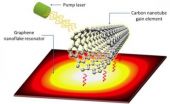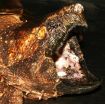(Press-News.org) Researchers at Ludwig-Maximilians-Universitaet (LMU) in Munich have identified the structural features that enable the innate immune system to discriminate between viral and endogenous RNAs in living cells.
When viruses infect cells, they take control of cellular metabolism and hijack cellular resources for the production of viral proteins. This process is dependent on viral RNA molecules that are delivered directly to (in the case of RNA viruses) and/or newly synthesized in the host cell, and provide the blueprints for the fabrication of viral proteins by the cell's translational apparatus. However, cells possess defense systems that are activated by specialized sensors that can distinguish viral RNAs from host RNAs. These proteins, three of which belong to the family of RIG-I like receptors (or RLRs), recognize and bind specifically to foreign RNAs. This in turn alerts the innate immune system, which proceeds to destroy the foreign RNAs, thus preventing the production of new virus particles. "Based on in-vitro experiments, it is known that RLR proteins bind to certain characteristic patterns in viral RNAs, but it had not been possible to isolate the precise RNA sequences bound by these proteins in living, virus-infected cells," says Professor Karl-Peter Hopfner of LMU's Genzentrum.
Tethering RNA to proteins with UV light
Hopfner, in collaboration with his colleagues Karl-Klaus Conzelmann (LMU), Johannes Söding (LMU) and Adolfo García-Sastre (Mount Sinai Hospital, New York), made use of a clever experimental strategy to get around this problem, which enabled them to purify and characterize ribonucleoprotein complexes containing viral RNAs from virus-infected cells. The intrinsic stability of the interaction between RLRs and viral RNAs is very low. So the researchers first had to stabilize the complexes in order to isolate them intact. For this purpose, they infected cells with measles virus, and incubated them in the presence of a chemically modified, photoactivatable RNA precursor, which is incorporated into newly synthesized viral RNAs. "Provided that the physical distance between an RNA and its binding protein is short enough, subsequent exposure of such cells to UV light induces the formation of a stable covalent bond between them," Hopfner explains.
The resulting RNA-protein complexes could then be isolated from the cells and, after detachment of the proteins, the nucleotide sequences of the RNAs could be determined. "This allowed us to determine how RLRs recognize foreign RNAs and how the latter differ from endogenous cellular RNAs," says Hopfner.
The researchers found that the RLR proteins RIG-I and MDA5 indeed recognize defined elements within viral RNAs in living cells that have been infected by measles virus. Like many other viruses, including the one that causes rabies, the measles virus possesses a single-stranded RNA genome. Unlike DNA viruses, it therefore delivers an RNA template directly into the host cell. However, this molecule must then be transcribed by its associated viral RNA polymerase to generate the mRNAs required for synthesis of viral proteins and propagation of the infection.
Sensors bind to specific regions
"And while RIG-I preferentially binds to certain sequence patterns found at the exposed ends of different viral RNAs both in vitro and in vivo, MDA5 rather surprisingly recognizes not the viral genome itself, but apparently certain regions located within viral mRNAs," Hopfner explains. Moreover, these regions differ in their base composition from sequences found in other viral RNAs, suggesting that MDA5 relies on these structural differences to discriminate between viral and endogenous RNAs.
Hopfner and his team now plan to investigate the interaction of RLRs with other viral nucleic acids, in order to obtain a clearer picture of the molecular mechanisms that enable these proteins to detect foreign RNAs. This should in turn shed light on why the innate immune system has difficulty in responding to particular viruses, and how RLR-associated autoimmune diseases such as rheumatoid arthritis arise. A better understanding of both of these issues could suggest new approaches to the treatment of both viral infections and autoimmunity.
INFORMATION: END
Viral infections: Identifying the tell-tale patterns
2014-04-24
ELSE PRESS RELEASES FROM THIS DATE:
How productive are the ore factories in the deep sea?
2014-04-24
About ten years after the first moon landing, scientists on earth made a discovery that proved that our home planet still holds a lot of surprises in store for us. Looking through the portholes of the submersible ALVIN near the bottom of the Pacific Ocean in 1979, American scientists saw for the first time chimneys, several meters tall, from which black water at about 300 degrees and saturated with minerals shot out. What we have found out since then: These "black smokers", also called hydrothermal vents, exist in all oceans. They occur along the boundaries of tectonic ...
HHS leaders call for expanded use of medications to combat opioid overdose epidemic
2014-04-24
A national response to the epidemic of prescription opioid overdose deaths was outlined yesterday in the New England Journal of Medicine by leaders of agencies in the U.S. Department of Health and Human Services. The commentary calls upon health care providers to expand their use of medications to treat opioid addiction and reduce overdose deaths, and describes a number of misperceptions that have limited access to these potentially life-saving medications. The commentary also discusses how medications can be used in combination with behavior therapies to help drug users ...
Treatment for deadly yeast disease reduced to 3 days
2014-04-24
Initial treatment for a brain infection caused by fungus could now be treated in three days, rather than two weeks, due to study by University of Liverpool scientists.
Cryptococcus – a form of yeast - infections are often fatal but are relatively neglected in medical research. They are found in many parts of the world, including Africa, Australasia and South East Asia and mainly affect people with weakened immune systems. This infection kills up to 700,000 people a year.
The University research team has tested the effects of the most commonly used drug on Cryptococcus ...
Animals with bigger brains, broader diets have better self control
2014-04-24
DURHAM, N.C. -- A new study representing the largest study of animal intelligence to-date finds that animals with bigger brains and broader diets have better self-control.
Published this week in the journal Proceedings of the National Academy of Sciences, the study is part of a long history of research aimed at understanding the animal mind. Specifically, why are some species able to do things like make and use tools, read social cues, or even understand basic math, and others aren't?
Until now, most studies of animal intelligence have focused on only one or a few ...
New ultrasound device may add in detecting risk for heart attack, stroke
2014-04-24
Researchers from North Carolina State University and the University of North Carolina at Chapel Hill have developed a new ultrasound device that could help identify arterial plaque that is at high risk of breaking off and causing heart attack or stroke.
At issue is the plaque that builds up in arteries as we age. Some types of plaque are deemed "vulnerable," meaning that they are more likely to detach from the artery wall and cause heart attack or stroke.
"Existing state-of-the-art technologies are capable of determining if plaque is present in the arteries, but can't ...
New study links inflammation in those with PTSD to changes in microRNA
2014-04-24
With a new generation of military veterans returning home from Iraq and Afghanistan, post-traumatic stress disorder (PTSD) has become a prominent concern in American medical institutions and the culture at-large. Estimates indicate that as many as 35 percent of personnel deployed to Iraq and Afghanistan suffer from PTSD. New research from the University of South Carolina School of Medicine is shedding light on how PTSD is linked to other diseases in fundamental and surprising ways.
The rise in PTSD has implications beyond the impact of the psychiatric disorder and its ...
Your T-shirt's ringing: Telecommunications in the spaser age
2014-04-24
A new version of "spaser" technology being investigated could mean that mobile phones become so small, efficient, and flexible they could be printed on clothing.
A team of researchers from Monash University's Department of Electrical and Computer Systems Engineering (ECSE) has modelled the world's first spaser (surface plasmon amplification by stimulated emission of radiation) to be made completely of carbon.
A spaser is effectively a nanoscale laser or nanolaser. It emits a beam of light through the vibration of free electrons, rather than the space-consuming electromagnetic ...
Protecting olive oil from counterfeiters
2014-04-24
Just a few grams of the new substance are enough to tag the entire olive oil production of Italy. If counterfeiting were suspected, the particles added at the place of origin could be extracted from the oil and analysed, enabling a definitive identification of the producer. "The method is equivalent to a label that cannot be removed," says Robert Grass, lecturer in the Department of Chemistry and Applied Biosciences at ETH Zurich.
The worldwide need for anti-counterfeiting labels for food is substantial. In a joint operation in December 2013 and January 2014, Interpol ...
Breast cancer replicates brain development process
2014-04-24
New research led by a scientist at the University of York reveals that a process that forms a key element in the development of the nervous system may also play a pivotal role in the spread of breast cancer.
A research team, led by Dr Will Brackenbury, a Medical Research Council Fellow in the Department of Biology at York, has studied how voltage-gated sodium channels assist in the metastasis of cancerous tumours. These channels are found in the membranes of excitable cells, such as neurons, where they are involved in transmission of electrical impulses. However, the ...
Two new US turtle species described
2014-04-24
The alligator snapping turtle is the largest river turtle in North America, weighing in at up to 200 pounds and living almost a century. Now researchers from Florida and the University of Vermont have discovered that it is not one species — but three.
Examining museum specimens and wild turtles, the scientists uncovered deep evolutionary divisions in this ancient reptile.
Once heavily hunted for turtle meat — alligator snapper was the main ingredient of Campbell's Turtle Soup in the 1960s — the riverine populations have been deeply depleted and are of conservation concern. ...




